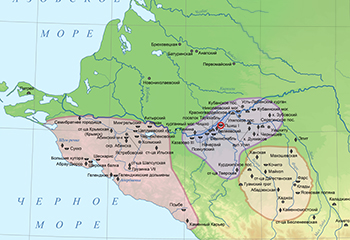Pshish-I
- Region:
- Eastern Europe
- Timespan:
- 9th —early 7th centuries BC
- Coordinates:
- 45.09
39.46
PSHISH-I — a burial ground on the left bank of the Pshish River from the Proto-Maeotian period. Pshish-I is located between the village Tauykhabl and khutor Gorodskoy in the Teuchezhsky District of the Republic of Adygea, Russia
PSHISH-I — a burial ground from the Proto-Maeotian period dated between 9th and early 7th centuries BC. It is located on the left bank of the Pshish River, which flows into the Krasnodar Reservoir, between the village Tauykhabl and khutor Gorodskoy in the Teuchezhsky District of the Republic of Adygea, Russia (Fig. 1).
.jpg)
Fig. 1. A Map of Main Archaeological Sites of the North-West Caucasus (Pre-Scythian Period)
.png)
Fig. 2. Pshish-I burial ground, Burial 3. 1 — bits; 2 — cheekpieces; 3, 3a — spacers; 4 — plaque; 4b — crescent; 5 — forehead plaque; 6 — pendants of the Sharengrad type. 1, 2–5 — bronze; 6 — gold.
In: Sazonov, A. A. “Ranniaia gruppa konskikh zakhoroneniĭ protomeotskogo mogilʹnika Pshish-I” [The Early Group of Horse Burials of the Proto-Maeotian Burial Ground Pshish-I]. Arkheologiia Adygei [The Archaeology of Adygea], edited by P. A. Ditler et al., Maĭkop: Meoty, 1995, pp. 84–107 (in Russian)
Discovery and Research
Pshish was discovered in 1986 during an archaeological excavation led by L. M. Noskova and conducted by the Caucasian Archaeological Expedition of the State Museum of the Oriental Art. Four Proto-Maeotian complexes, including a horse burial, were studied the same year [Kozhukhov, Erlikh 1988: 153–157]. In 1988, a chariot harness, known as the Pshish treasure, was discovered while excavating ancient graves.
From 1990 to 1996, the necropolis with more than 130 burial and cult complexes was explored by A. A. Sazonov. The joint Caucasian Archaeological Expedition of the State Museum of the Oriental Art and the Institute of Archaeology of the Russian Academy of Sciences under the leadership of V. R. Erlich resumed the work on the site in 2004–2005 [Valchak 2007; Erlikh, Valchak 2007].
Burial Features
The burial ground consists of single graves. Male skeletons are primarily stretched out on their backs while the female bodies are mostly in crouched position. About 70% of the skeletons have their heads pointing to the northwest.
The earliest burials are characterised by horse sacrifices — stuffed animals (skull and limb bones) with a bridle or horse skin (Fig. 2) [Sazonov 1995: 84–107]. Later sacrifices consist of several skins, or stuffed horses with chariot harnesses, or just clusters of chariot harnesses [Sazonov 2000: 65–66, fig. 9–10; Erlikh 1994: 45, tab. 7, 1–11; 2007: 45, 150–151].
Finds
The burial inventory is extremely rich and diverse (Fig. 3). It includes ceramic ladles, pots, and bowls as well as bronze and iron spearheads, bronze, iron, and bimetallic daggers and iron axes. In addition, the men’s graves contain bronze and iron knives and whetstones. Rich male military graves also feature gold and silver pendants of the Sharengrad type. Items found in the women’s graves include pins of various types, glass beads, and spindle whorls.
Periodisation
Bridle accessories found during excavations include both bone and bronze cheekpieces of perforated ‘steppe’ and loopshaped types. Based on changes in the bridle accessories and in the shape of the ceramic ladles, A. A. Sazonov suggested three periods of the burial ground existence between the 9th and the early 7th centuries BC [Sazonov 1996; 2004].
.png)
Fig. 3. Pshish-I Burial Ground (Excavations Conducted by V. R. Erlikh and S. B. Valchak, 2004).
1–4 (burial 15); 5–10 (burial 23); 11–13 (burial 29); 14–16 (burial 35). 1, 2, 10 — ladles; 3, 15 — spearheads; 4, 9 — whetstones; 5 — bits; 6 — cheakpieces; 7, 8, 11, 16 — plaques; 12, 13 — pins; 14 — dagger.
1, 2, 10 — pottery; 3 — iron and bronze; 4, 9 — stone; 5–8, 13, 15, 16 — bronze; 6 — horn; 14 — iron.
In: Erlikh, V. R., and S. P. Valchak. “Protomeotskie pogrebeniia mogilʹnika Pshish-I (raskopki 2004 g.)” [Proto-Maeotian Burials at Pshish-I Burial Ground (Archaeological Excavations of 2004)]. Materialy i issledovaniia po arkheologii Kubani [Materials and Research on the Archaeology of Kuban Region], edited by I. I. Marchenko, vol. 6, Krasnodar: KubGU [Kuban State University], 2007, pp. 85–123 (in Russian)
Bibliography
Erlikh 1994 — Erlikh, V. R. U istokov ranneskifskogo kompleksa [Origins of Early Scythian Complex]. Moscow: GMV [State Museum of the Oriental Art], 1994 (in Russian). Erlikh 2007 — Erlikh, V. R. Severo-Zapadnyĭ Kavkaz v nachale zheleznogo veka. Protomeotskaia gruppa pamiatnikov [The North-West Caucasus in the Beginning of the Iron Age. Proto-Maeotian Monuments]. Moscow: Nauka, 2007 (in Russian). Erlikh, Valchak 2007 — Erlikh, V. R., and S. P. Valchak. “Protomeotskie pogrebeniia mogil’nika Pshish-I (raskopki 2004 g.)” [Proto-Maeotian burials at Pshish-I burial ground (archaeological excavations of 2004]. Materialy i issledovaniia po arkheologii Kubani [Materials and Research on the Archaeology of Kuban Region], edited by I. I. Marchenko, vol. 6, Krasnodar: KubGU [Kuban State University], 2007, pp. 85–123 (in Russian). Kozhukhov, Erlikh 1988 — Kozhukhov, S. P., and V. R. Erlikh. “Arkheologicheskie razvedki levogo berega Krasnodarskogo vodokhranilishcha” [Archaeological Survey of the Left Bank of the Krasnodar Reservoir]. Material’naia kul’tura Vostoka [Material Culture of the Orient], edited by S. V. Volkov, vol. II, Moscow: Nauka, 1988, pp. 147–170 (in Russian). Sazonov 1995 — Sazonov, A. A. “Ranniaia gruppa konskikh zakhoroneniĭ protomeotskogo mogil’nika Pshish-I” [The Early Group of Horse Burials of the Proto-Maeotian Burial Ground Pshish-I]. Arkheologiia Adygei [The Archaeology of Adygea], edited by P. A. Ditler et al., Maĭkop: Meoty, 1995, pp. 84–107 (in Russian). Sazonov 1996 — Sazonov, A. A. “Otnositel’naia i absoliutnaia khronologiia protomeotskogo mogil’nika Pshish-I” [Relative and Absolute Dating of the Proto-Maeotian Burial Ground Pshish-I]. Aktual’nye problemy arkheologii Severnogo Kavkaza: XIX Krupnovskie chteniia (Moskva, apr. 1996 g.): tez. dokl. [The Issues of North Caucasian Archaeology. The XIXth Krupnov Readings (Proceedings of the International Scientific Conference, Moscow, April 1996)], edited by G. E. Afanas’ev, Moscow: Institute of Archaeology, 1996, pp. 132–134 (in Russian). Sazonov 2000 — Sazonov, A. A. “Khadzhokhskie kurgany — nekropol’ drevnemeotskikh vozhdeĭ” [Khadzhokh Kurgans — Necropolis of Ancient Maeotian Chiefs]. Informatsionno-analiticheskiĭ vestnik [The Journal of Information and Analytics], No. 3, Maĭkop: ARIGI [Adyghe Republican Institute of Humanitarian Research], 2000, pp. 42–67 (in Russian). Sazonov 2004 — Sazonov, A. A. “O khronologii protomeotskikh pogrebeniĭ Zakuban’ia” [On the Сhronology of Proto-Maeotian Burials of Trans-Kuban Region]. Kimmerowie, Scytowie, Sarmaci. Księga Poświęcona Pamięci Profesora Tadeusza Sulimirskiego [Cimmerians, Scythians, Sarmatians. Work in Memory of Prof. T. Sulimirski], edited by J. Chochorowski, Kraków: Księgarnia Akademicka, 2004, pp. 389–407 (in Russian). Valchak 2007 — Valchak, S. P. “Raboty Kubanskogo otriada v Respublike Adygeia” [The work of the Kuban unit in the Republic of Adygea]. Arkheologicheskie otkrytiia 2005 g. [Archaeological Discoveries of 2005], edited by N. V. Lopatin, Moscow: Nauka, 2007, pp. 300–301 (in Russian).


